Memories in Weaving: Oyama City Kurumaya Museum of Art, Tochigi, Japan
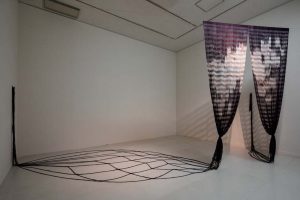
The Landscape at Which She Gazes, 2008
I-kat, printing i-kat, discharge dyeing, macram on silk, brass hook
Dimensions variable
Photo: Shinya Kigure
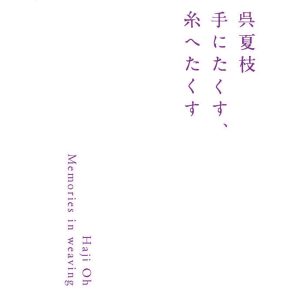
Exhibition Catalogue
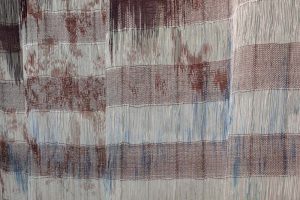
The Landscape at Which She Gazes, 2008
I-kat, printing i-kat, discharge dyeing, macram on silk, brass hook
Dimensions variable
Photo: Shinya Kigure
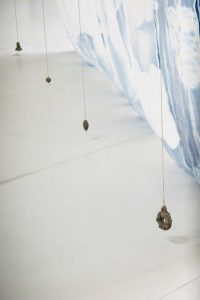
Ama’s home/boat floating on memory with the colour of emptiness, 2018
Cyanotype on used ramie and cotton cloth from Kanazawa, linen yarn, sinker, fishhook
Dimensions variable
Photo: Shinya Kigure
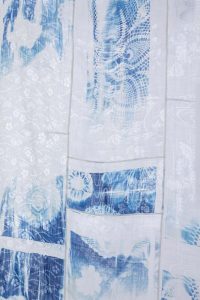
Ama’s home/boat floating on memory with the colour of emptiness, 2018
Cyanotype on used ramie and cotton cloth from Kanazawa, linen yarn, sinker, fishhook
Dimensions variable
Photo: Shinya Kigure
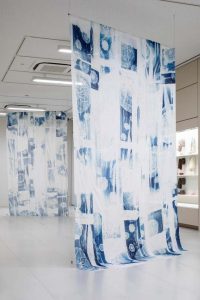
Ama’s home/boat floating on memory with the colour of emptiness, 2018
Cyanotype on used ramie and cotton cloth from Kanazawa, linen yarn, sinker, fishhook
Dimensions variable
Photo: Shinya Kigure
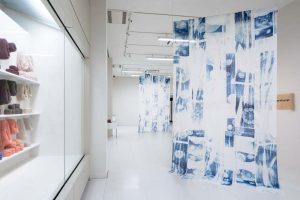
Ama’s home/boat floating on memory with the colour of emptiness, 2018
Cyanotype on used ramie and cotton cloth from Kanazawa, linen yarn, sinker, fishhook
Dimensions variable
Photo: Shinya Kigure
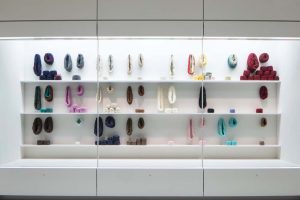
Thread of Memory, 2012-2013
Unraveled knitted items
Dimensions variable
Photo: Shinya Kigure
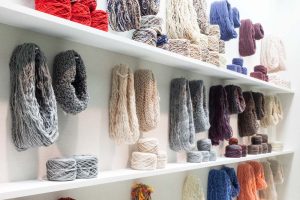
Thread of Memory, 2012-2013
Unraveled knitted items
Dimensions variable
Photo: Shinya Kigure
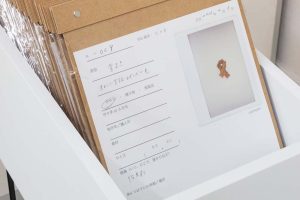
Thread of Memory, 2012-2013
Document card of unraveled knits
Dimensions variable
Photo: Shinya Kigure
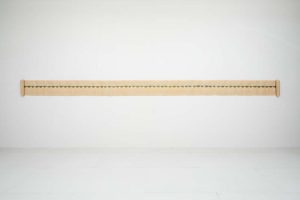
Three Generations of Time, 2004
Sanbe (hemp cloth), thermal transfer print paper, Photo on fabric
45 × 500 cm
Photo: Shinya Kigure
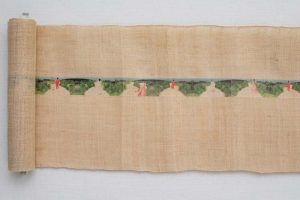
Three Generations of Time, 2004
Sanbe (hemp cloth), thermal transfer print paper, Photo on fabric
45 × 500 cm
Photo: Shinya Kigure
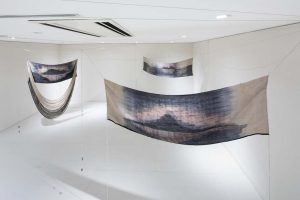
Nautical Map, 2017
Plain-woven, Warp-faced pick-up patterns, Four-selvaged cloth on Linen, lead
Dimensions variable
Photo: Shinya Kigure
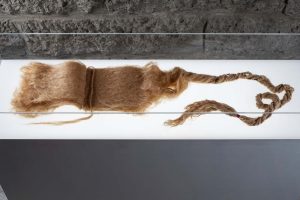
Another Story, 2010
Jute rope, silk yarn, audio voice
Dimensions variable
Photo: Shinya Kigure. Audio text reference: Joy Kogawa. Obasan. Toronto, ON: Penguin, 1983 [1981].
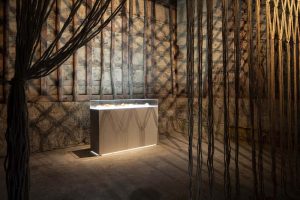
Another Story, 2010
Jute rope, silk yarn, audio
Dimensions variable
Photo: Shinya Kigure
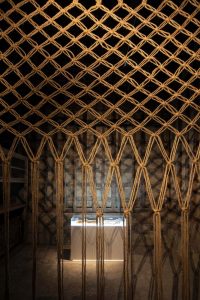
Another Story, 2010
Jute rope, silk yarn, audio
Dimensions variable
Photo: Shinya Kigure
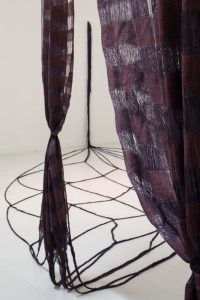
The Landscape at Which She Gazes, 2008
I-kat, printing i-kat, discharge dyeing, macram on silk, brass hook
Dimensions variable
Photo: Shinya Kigure
Haji Oh
12 Oct - 15 Dec 2019
Oh’s first solo show in Japan, this exhibition traced her oeuvre, from her early photographic works of traditional Korean clothing, inspired by her Korean roots, to her recent project, “Grand-mother Island,”. Memories In Weaving showcased installations of hand-woven, dyed, and bleached textiles, sound, and photography, that underline the concept of “post-memory” and the reconstruction of memories.
Reading World History by Unraveling Woven Textiles
Textiles were traded worldwide by merchants in ancient times and by multinational corporations in the modern era. The process of making textiles itself is maintained by local tradition, collective knowledge and physical technique. This two-sided aspect of textiles, both global and local, can be said to represent the complexity of modern people’s lives. Oh Haji uses various techniques including weaving, knitting, stitching and knotting as well as materials and skills that have been handed down as custom and tradition among different ethnic groups and regions. Her multi-dimensional method explores the socio-economic dimension of handcraft and the practice of dyeing and weaving in daily life. Through working with textiles, which are universal in human life and a symbol of our existence and belonging, she reflects on the relationships between people and that between humans and society. Her work using thread and fabric recounts and imagines the past that belongs to particular individuals and reconstructs their history. This approach derives from the artist’s background as a third-generation ethnic Korean woman who grew up in Japan where the majority of the population prefers being passive observers of the country’s past aggressions, and few people can afford to reveal their Korean heritage. This is at the core of Oh’s creation but her positionality is not immutable; it constantly experiences temporal-spatial movement, constant change and renewal. From this position her work suggests to us the possibility of representing and inheriting memory. Because she lacks a direct relationship to her ancestor’s country, Oh starts from examining the memory of her grandmother who migrated from Jeju Island, South Korea to Osaka. A series of works using the theme of ethnic costume can be understood through the concept of ‘post memory’: the ‘generation after’ which lacks memories based on direct experience but gains pseudo-memory by retracing the experience of those who came before, with the purpose of bridging the gap existing between generations. Oh’s work stimulates individual experiences and memories in the audience and re-produces them. This leads the audience to extend their imagination to the grandmother’s silent memory; thus, remembering becomes a reciprocal act and the memory is re-constructed as multi-layered beyond the boundary between those who did and did not experience the events, and that between ethnic Koreans and others. Oh’s search for identity through her grandmother encourages the audience to direct their imagination towards the identities of others that constitute the society. It leads us not to avert our eyes from historical memory, especially that of Japan’s colonization; otherwise, the existence of her grandmother would be extinguished. Her approach of extending the imagination towards the memory of others and constructing new memory can be regarded as an applied practice of the concept of ‘post memory’ which originally focused on how memory is inherited in families that have survived traumatic events. Oh adopts this methodology by introducing a letter appearing in the novel of a Japanese Canadian writer and evoking personal memories residing in knitting and crochet mats, and stimulates past memories that participants themselves have forgotten. Oh uses the hogushigasuri (warp printing) technique in works using ethnic costume, The Landscape at which She Gazes (2008) and the ongoing grand-mother island project. This technique creates subtle gaps in the contours of images reminding us of the past woven into the present and its obscure outline evokes the artist’s positionality in Japanese society. Oh clarifies where she stands in the society but does not stress it too much so as not to create a dichotomy. “Every human being is to some extent a mixed-race child and migrant,” as Suga Keijiro states; the nation is essentially constituted from a range of peoples like graduated patterns in kasuri fabric. Time-consuming handweaving techniques including that of kasuri have declined in the era of modernization. One of the features of modernity is the reduction of working hours. Looking from today’s point of view, the technique of kasuri expresses the irrelevance of the modern value of efficiency for traditional weavers. The techniques used in Oh’s work including macramé, the Korean patchwork technique jogakbo, and others reveal her intention to resist the spirit of modernity where everything is valued according to the notion of efficiency. The process of making artwork using your body in time consuming tasks is to question the meaning of your body. Dyeing and weaving are generally regarded as women’s work worldwide, but there are some places where they are considered masculine, for example, in Africa or India. This has evolved not only for physical reasons, but has also been historically embedded in the social structure. Especially in Japan, the association between handcrafts and women, and that of free domestic labor and femininity was created by the state in the process of modernization. However, Oh’s Workshop as Research projects look beyond such conventional roles given to handcrafts and associate them with modern practices related to recreation and gift exchange. Handcrafts function here as a medium to relate different people and help them connect to their community; you can say this is a positive change for women who have acquired handcraft skills through an oppressive social structure. Workshop participants and the artist establish relationships based on trust through their shared experience.
Oh’s interest is recently more focused on work that questions the notion of individual subjectivity. She goes beyond the boundary of nation, deconstructing the conventional female image related to textile-making, releases dyeing and weaving from gender confines and redefines them as human activity; this is an attempt to dismantle human history and reconstruct it from countless voices and stories of individuals.
-Nakao Hanae (Curator, Kurumaya Museum of Art, Oyama City)
